#ozark softscape
Photo
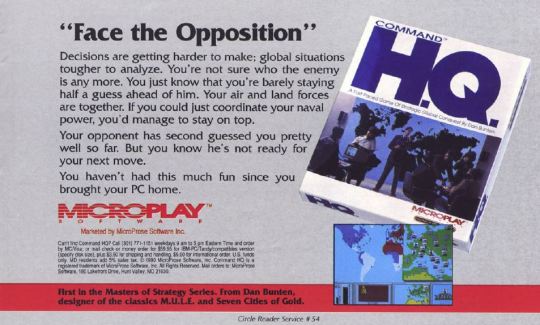
USA 1990
9 notes
·
View notes
Photo
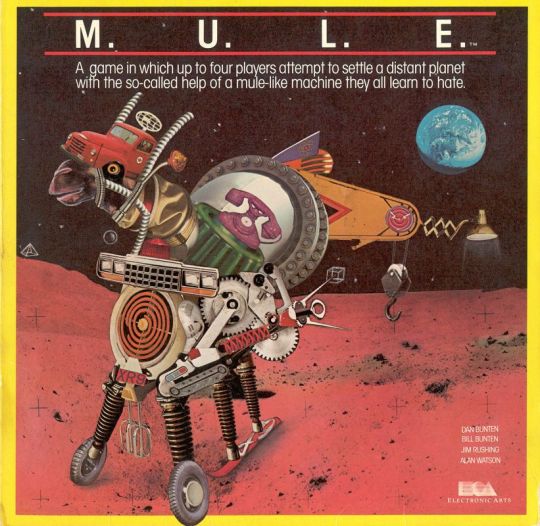


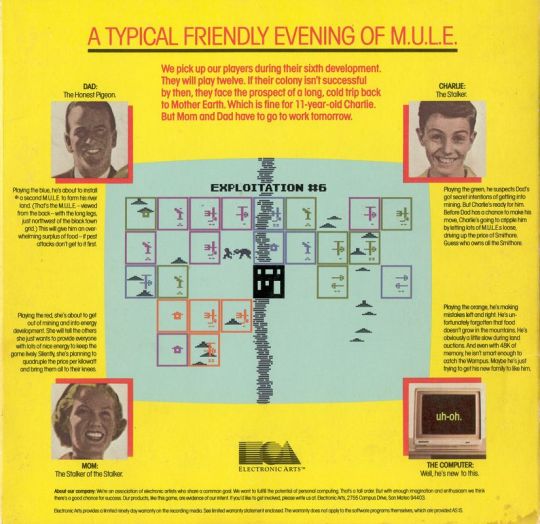
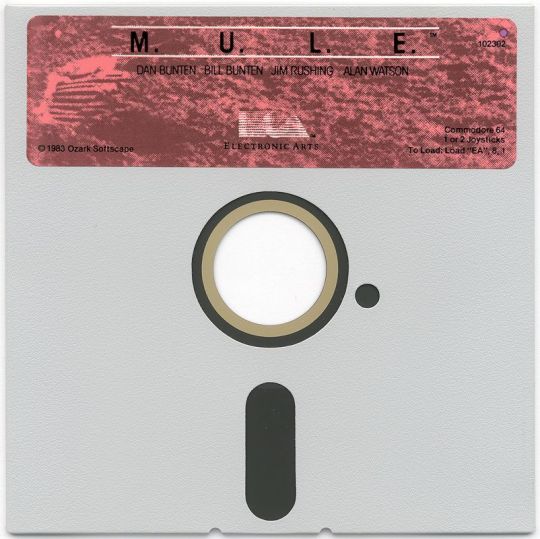
M.U.L.E. (C64)
#m.u.l.e.#c64#commodore 64#ozark softscape#game#games#video game#video games#simulation#sim#scifi#science fiction#game art#box art#floppy disk
0 notes
Text

Electronic Art's "MULE" for the Atari 400/800/1200 computer
Released in 1983 by Electronic Arts for the Atari 400/800, "M.U.L.E." is a seminal video game that combines elements of strategy, resource management, and economic simulation in a multiplayer format. Designed by Dan Bunten (later Danielle Bunten Berry) of Ozark Softscape, "M.U.L.E." is recognized not only for its innovative gameplay but also for fostering social interaction and strategic thinking among players. It remains a beloved classic for its pioneering approach to multiplayer gaming and its enduring game design principles.
Historical Context
The early 1980s marked a vibrant period for the home computer market, with the Atari 400/800 series emerging as significant platforms due to their advanced graphic and sound capabilities relative to competitors. This era witnessed the rise of software companies eager to explore these new technologies, among them Electronic Arts, which was founded with the vision of supporting software developers as artists. "M.U.L.E." was among the first titles released under this new banner, exemplifying the company's commitment to innovative and thoughtful game design.
Gameplay and Design
"M.U.L.E." allows up to four players to colonize a distant planet, competing and cooperating to manage the allocation of resources such as food, energy, smithore (used to make MULEs—Multiple Use Labor Elements), and crystite. The gameplay involves strategic placement of MULEs on various plots of land to harvest resources, which are then used to sustain the colony and can be bought or sold in a dynamic marketplace that simulates supply and demand economics.
One of the most innovative aspects of "M.U.L.E." is its emphasis on economic principles, making it one of the first games to incorporate complex economic algorithms that impact player decisions. It also promotes social interaction through its auction system, where players negotiate and trade resources, requiring real-time decision-making that enhances the game’s dynamic feel.
Technological Innovations
"M.U.L.E." was technologically significant for several reasons. Firstly, its graphic design was highly effective yet simple, with clear, colorful representations of the game world that made complex information accessible and engaging. The user interface was ahead of its time, providing players with easy navigation and management of in-game actions, which was crucial for a game with such depth.
Secondly, the game made excellent use of the Atari 400/800's capabilities, particularly in handling multiple players in a turn-based setting without sacrificing pace or engagement. This was a remarkable achievement that set a precedent for future multiplayer games.
Cultural Impact and Legacy
"M.U.L.E." is beloved by those who played it for several reasons. It was one of the first games to effectively blend competitive and cooperative gameplay, creating a unique social experience in video gaming. The game's ability to forge a communal spirit among players, coupled with the intellectual challenge of managing economic variables, made it not only fun but a mentally stimulating experience.
The game's influence extends beyond just gameplay; it is cited as an inspiration by numerous game developers who appreciated its balanced game mechanics and economic simulation aspects. "M.U.L.E." laid the groundwork for many future simulations and strategy games, and its principles can be seen in modern titles that incorporate complex economic systems and multiplayer components.
Conclusion
"M.U.L.E." remains a landmark in video game history, notable for its innovative approach to gameplay, technology, and social gaming dynamics. It stands out not only as a product of its time but also as a forward-thinking creation that predicted and shaped future developments in the gaming industry. For many, "M.U.L.E." was more than just a game; it was a compelling social and strategic experience that has endured in memory and influence, continuing to inspire game designers and players alike with its timeless design and gameplay.
#EA#Electronic Arts#Trip Hawkins#Atari#Atari 400#Atari 800#Atari 1200#MULE#Retro#Game#Retro game#Retro gaming#Pixel Crisis
0 notes
Text




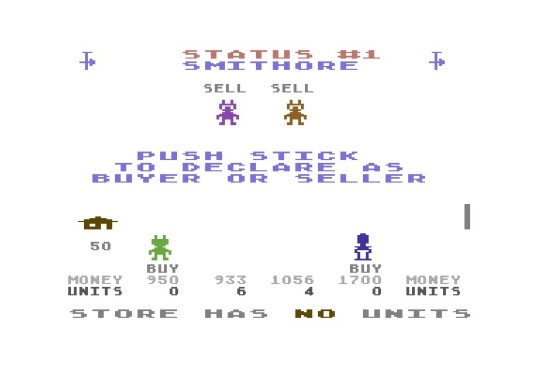


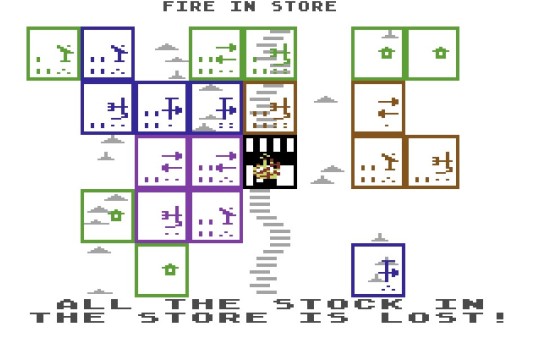
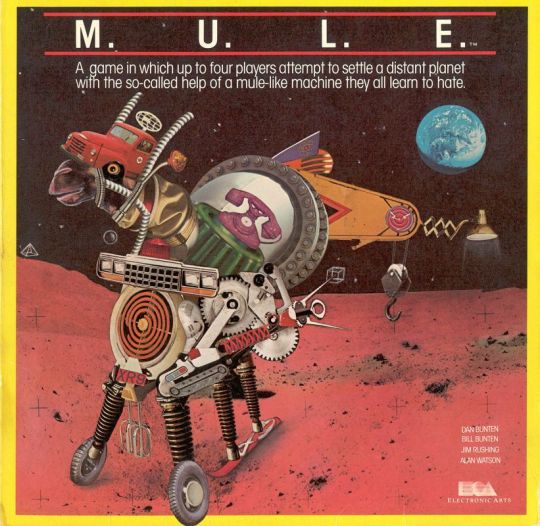
112.) M.U.L.E.
Release: 1983 | GGF: Action, Strategy/Tactics, Management, Board Game, Simulation | Developer(s): Ozark Softscape | Publisher(s): Electronic Arts, Inc., Ariolasoft UK, International Business Machines Corporation, Bullet-Proof Software, Inc., Mindscape, Inc., Ozark Softscape | Platform(s): Atari 8-bit (1983), Commodore 64 (1983), IBM PC (1985), PC Booter (1985), PC-88 (1987), MSX (1988), Sharp X1 (1988), NES (1990), Windows (2021), itch.io (2023)
0 notes
Text
wikipedia fact
Joe Ybarra worked at Apple Computer before leaving in 1982 to work at Electronic Arts, a startup company founded by his fellow ex-Apple employee, Trip Hawkins. There he became one of the original game producers and game designers at Electronic Arts in 1982 (along with Stewart Bonn, Dave Evans (Apple), Susan Lee-Merrow and Pat Marriott), where the concept of a game producer was created by Trip Hawkins. During this time he produced several highly acclaimed computer games, including M.U.L.E. by Dani Bunten and Ozark Softscape, Seven Cities of Gold (also by Bunten), Starflight and Dr. J. and Larry Bird Go One on One by Eric Hammond. Ybarra was also the original producer on the first version of Madden NFL.
0 notes
Photo

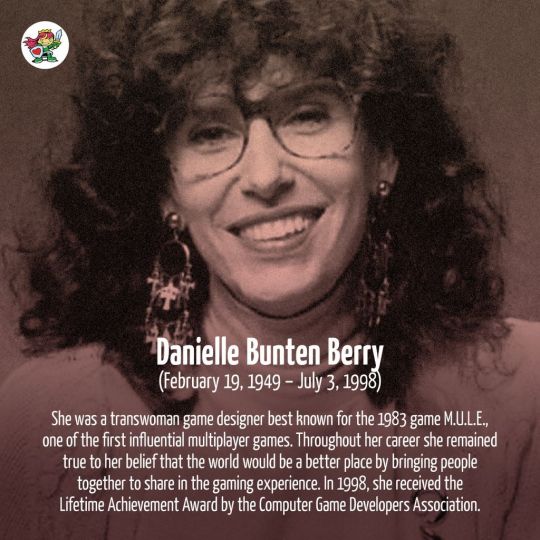

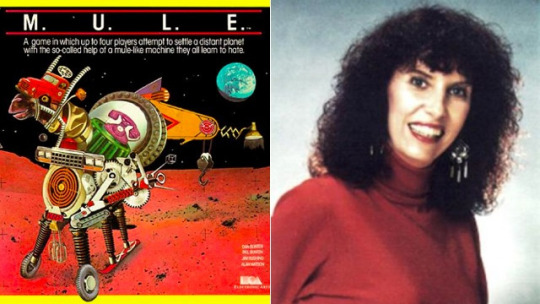

Danielle Bunten Berry (February 19, 1949 – July 3, 1998), formerly known as Dan Bunten, was an American game designer and programmer, known for the 1983 game M.U.L.E., one of the first influential multiplayer video games, and 1984's The Seven Cities of Gold.
In 1998, she was awarded the Lifetime Achievement Award by the Computer Game Developers Association. In 2007, the Academy of Interactive Arts & Sciences chose Bunten as the 10th inductee into its Hall of Fame.
Bunten was born in St. Louis, Missouri and moved to Little Rock, Arkansas as a junior in high school. She was the oldest of six siblings. While growing up in Little Rock, Bunten's family didn't always have enough money to make ends meet, so Bunten took a job at a pharmacy. She also held a leadership role with the Boy Scouts.
According to Bunten, one of her fondest childhood memories involved playing games with her family. She was quoted saying, “When I was a kid, the only times my family spent together that weren’t totally dysfunctional were when we were playing games. Consequently, I believe games are a wonderful way to socialize.”
While attending the University of Arkansas, she opened up her own bike shop called Highroller Cyclerie. Bunten acquired a degree in industrial engineering in 1974 and started programming text-based video games as a hobby. After she graduated from college, she was employed by the National Science Foundation, where she created urban models before starting a job at a video game company.
In 1978, Bunten sold a real-time auction game for the Apple II titled Wheeler Dealers to a Canadian software company, Speakeasy Software. This early multiplayer game required a custom controller, raising its price to USD$35 in an era of $15 games sold in plastic bags. It sold only 50 copies.
After producing three titles for SSI, Bunten, who by then had founded a software company called Ozark Softscape, caught the attention of Electronic Arts founder Trip Hawkins. M.U.L.E. was Bunten's first game for EA, originally published for the Atari 8-bit family because the Atari 800 had four controller ports. Bunten later ported it to the Commodore 64. While its sales - 30,000 units - were not high, the game developed a cult following and was widely pirated. The game setting was inspired by the novel Time Enough for Love by Robert A. Heinlein.
Along with the success of M.U.L.E., Berry also had close ties with the games Robot Rascals, Heart of Africa, and Cartels & Cutthroat$. Throughout her career, she was involved in the creation of 12 games, 10 of which revolved around multiplayer compatibility. The only two which didn't have a multiplayer focus were Seven Cities of Gold and Heart of Africa.
Bunten wanted to follow up M.U.L.E. with a game that would have been similar to the later game Civilization, but after fellow Ozark Softscape partners balked at the idea, Bunten followed with The Seven Cities of Gold, which proved popular because of its simplicity. By the time the continent data were stored in the computer's memory, there was little left for fancy graphics or complex gameplay - the game had only five resources. It was a hit, selling more than 150,000 copies.
The follow-up game, Heart of Africa, appeared in 1985 and was followed by Robot Rascals, a combination computer/card game that had no single-player mode and sold only 9,000 copies, and 1988's Modem Wars, one of the early games played by two players over a dial-up modem. Modem Wars was ahead of its time, as few people in the late 1980s had modems in their homes.
Bunten departed EA for MicroProse. Allegedly, Trip Hawkins, CEO of EA, did not feel that pushing production of games onto a cartridge based system was a good idea. The shift was important to Bunten, as computer games had previously been distributed on floppy discs, and a changeover to a cartridge system would allow games to be played on Nintendo systems. This was a significant factor in her decision to leave. She then developed a computer version of the board game Axis and Allies, which became 1990's Command HQ, a modem/network grand strategy wargame. Bunten's second and last game for MicroProse was 1992's Global Conquest, a 4-player network/modem war game. It was the first 4-player network game from a major publisher. Bunten was a strong advocate of multi-player online games, observing that, "No one ever said on their deathbed, 'Gee, I wish I had spent more time alone with my computer.'"
A port of M.U.L.E. to the Mega Drive/Genesis was cancelled after Bunten refused to put guns and bombs in the game, feeling it would alter the game too much from its original concept. In 1997, Bunten shifted focus to multiplayer games over the Internet with Warsport, a remake of Modem Wars that debuted on the MPlayer.com game network.
Less than a year after the release of Warsport, Bunten was diagnosed with lung cancer presumably related to years of heavy smoking. She died on July 3, 1998. At the time, she was working on the design of an Internet version of M.U.L.E..
The game's primary premise consisted of players playing with and against one another to establish total control over a planet. The name of the game stands for Multiple Use Labor Element. The game was originally made for the Atari 400 and Atari 800 but was later developed to be compatible with the Commodore 64, NES, and IBM pcjr. The game has a maximum of four players. Players are given different options and choices, and are allowed to create their colony the way they see fit. This can be done by changing races and giving respective colonies different advantages that will impact the way the game is played and determined later on down the line.
Ultimately there are two ways in which players can win the game. The first way is by having the most amount of money out of all four players, and the second way is by being able to survive the colony itself. The game focuses heavily on going out and retrieving resources that can be used to benefit their character. Items such as food, energy, and crystite are some of a number of in-game items that players are able to retrieve and use to better themselves. In order for a player to be able to access these items, they will first have to have access to a M.U.L.E. The acquisition of these items has a direct reflection on what the player will be allowed to do. For example, if a player doesn't have enough food, they will have less time during their turn.
The Seven Cities of Gold was originally intended to be another multiplayer game. It was originally a single player format, focused heavily on having the players travel around the map and collect items to help them strengthen their colony. Once they felt as though they had a solid colony, the players could battle each other to see who could overtake who After much consideration, Ozark Software came to the conclusion that this would not be doable. Instead, they went with a formula that had the game focus solely on developing a colony.
Ozark Softscape was a computer game development team consisting initially of Danielle Bunten, her brother Bill Bunten, Jim Rushing, and Alan Watson. Ozark was run out of Bunten's basement. The company was based out of Little Rock, Arkansas and had profound success with a few of their early titles. Ozark Softscape had a publishing deal with Electronic Arts for several of its groundbreaking games. In the early 1990s, Ozark Softscape left its partnership with Electronic Arts over a dispute to port some games to cartridge format for the Nintendo Entertainment System. It began a partnership with MicroProse to produce two more titles: Command HQ and Global Conquest. A dispute occurred over creating a follow-up to M.U.L.E. with Sega in 1993, and the company dissolved. The employees of Ozark Softscape moved to different areas of the software industry.
Bunten was married three times. Bunten had three children, one daughter and two sons. After a third divorce, Bunten, who had until then been living as male, transitioned to living as a woman. Bunten underwent sex reassignment surgery in November 1992 and afterward kept a lower profile in the games industry. Bunten later regretted having surgery, finding that for her, the drawbacks of surgical transition outweighed the benefits, and wishing she had considered alternative approaches. She joked that the surgery was to improve the video game industry's male/female ratio and aesthetics, but advised others considering a sex change not to proceed unless there was no alternative and warned them of the cost, saying "Being my 'real self' could have included having a penis and including more femininity in whatever forms made sense. I didn't know that until too late and now I have to make the best of the life I've stumbled into. I just wish I would have tried more options before I jumped off the precipice."
After her transition in fall 1992, Bunten stayed out of the video game spotlight, mostly keeping to herself. She felt as though that after transitioning she was not as good at video game development as she had previously been, stating "So, I'm a little more than three years into my new life role as Ms. Danielle Berry, and her career looks to be somewhat different from old Mr. Dan Bunten's. For one thing, I'm not as good a programmer as he was." On July 3, 1998, Berry died of lung cancer.
Wheeler Dealers (1978)
Cartels & Cutthroats (1981)
Computer Quarterback (1981)
Cytron Masters (1982)
M.U.L.E. (1983)
The Seven Cities of Gold (1984)
Heart of Africa (1985)
Robot Rascals (1986)
Modem Wars (1988)
Command HQ (1990)
Global Conquest (1992)
Warsport (1997)
Although many of Bunten's titles were not commercially successful, they were widely recognized by the industry as being ahead of their time. On May 7, 1998, less than two months before her death, Berry was awarded the Lifetime Achievement Award by the Computer Game Developers Association.
In 2000, Will Wright dedicated his blockbuster hit The Sims to Bunten's memory. In 2007, the Academy of Interactive Arts & Sciences chose Bunten to be inducted into its Hall of Fame. Sid Meier, the mastermind behind the video game series Civilization, inducted her at the Hard Rock Hotel in Las Vegas.
Bunten was a true pioneer for the video game industry, especially its multiplayer aspect of it. She is regarded by many as one of the best designers to ever grace the video game industry. Her success has even led people to make the claim that the work she did with games like M.U.L.E and Seven Cities of Gold was the inspiration behind highly successful modern multiplayer games like World of Warcraft.
Bunten was known as someone who was very easy to talk to. If someone recognized her in public, she would be more than delighted to have a conversation with them.
#transgender#transition#postop transwomen#transwoman#transwomenmatter#computer programmer#mtf vaginoplasy#mtf breast implants#srs#rest in peace
45 notes
·
View notes
Text
How Danielle Bunten Berry Helped Inspire Multiplayer Gaming

Though not many people today may be aware, Danielle Bunten Berry was one of the key minds that helped to kickstart the video game industry. Bunten, who was born in St. Louise, MO, spent much of her time as a child playing games with her family. Some of her fondest childhood memories involved her and her family playing games together and found that games were a wonderful way for people to socialize with one another.
Early Career
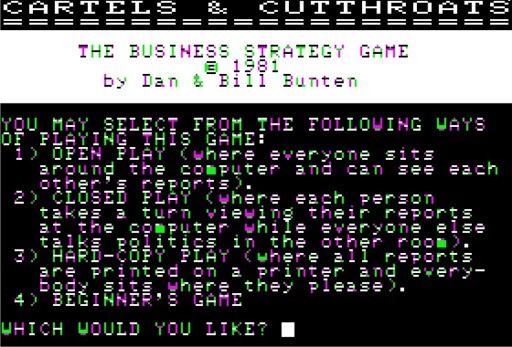
Game Designers Remembered
She eventually went to college at the University of Arkansas, where she acquired a degree in industrial engineering in 1974. From there, Bunten began programming text-based video games as a side hobby. After graduation, Bunten got a job working for the National Science Foundation, where she created urban models before starting a job at a video game company.
Working for video game company Speakeasy Software, Bunten developed her very first video game titled Wheeler Dealers for the Apple II. It was one of the very first multiplayer video games and was even sold with a custom controller that allowed for multiple players. Unfortunately, the custom controller raised the game’s price to $35, in an era where the standard computer game sold for only $15. As a result, Wheeler Dealer only managed to sell 50 copies. However, Wheeler Dealer was followed up by three more titles for SSI, an early game publisher: Computer Quarterback (1978), Cartels & Cutthroats (1979), and Cytron Masters (1982).
Partnership with EA and M.U.L.E.
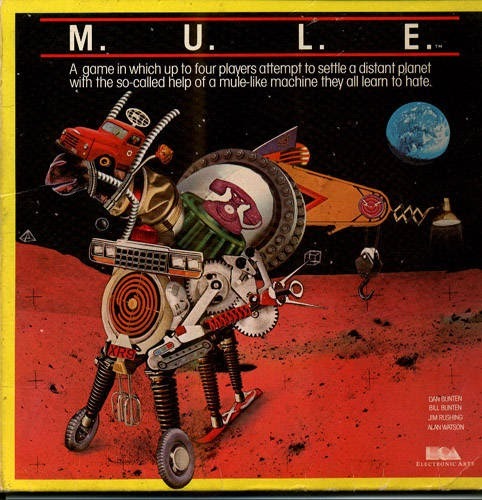
The Games DB
Bunten later founded the software company Ozark Softscape, which caught the attention of Electronic Arts founder Trip Hawkins; Bunten partnered with EA and developed the title M.U.L.E. for the Atari 8-bit family of consoles. The game benefitted from Atari’s four controller ports and was one of the first multiplayer games for the system. M.U.L.E. was later ported over to the Commodore 64 and developed a wide cult following. It only sold around 30,000 units, however, its popularity grew over time and became a widely pirated game.
Success after M.U.L.E.
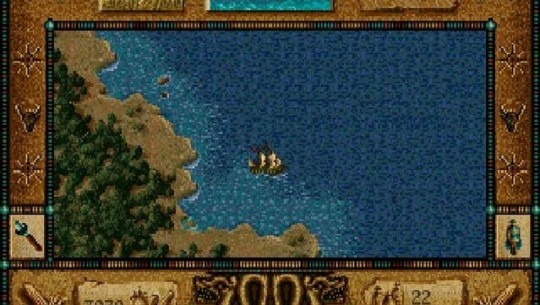
GOG
After M.U.L.E.’s success, Bunten went on to assist in the development of 12 games in total, ten of which had multiplayer support, including games such as Robot Rascals, Heart of Africa, and Modern Wars. Many of these games were revolutionary and arguably ahead of their time, with Modern Wars being one of the first games to support two players playing online via a dial-up modem. Modern Wars sold poorly, as it was released in an era where very few people possessed modems.
Bunten intended on creating an online game that would have been similar to the later game Civilization, however Ozark Softscape didn’t wind up going with the idea, and the title became The Seven Cities of Gold, an offline strategy title that focused on resource management. The game wound up becoming incredibly popular, selling more than 150,000 copies.
Bunten eventually left EA to work for MicroProse, allegedly because EA’s CEO Trip Hawkins didn’t believe in pushing production of games onto cartridges was a good idea, whilst Bunten felt otherwise. From there, Bunten developed a computer version of the board game Axis and Allies, which became the 1990 game Command HQ, a modem-based online grand strategy wargame. In 1992, Bunten developed her second (and final) game for MicroProse, a 4-player network/modem war game entitled Global Conquest. The title was revolutionary, as it was the first video game by a major publisher that featured 4-player online gameplay.
Later Years

Reddit
In 1997, Bunten shifted her focus to online multiplayer games with the creation of Warsport, a remake of Modem Wars that made its debut on the MPlayer.com gaming network. Less than a year later after Warsport’s release, Bunten was diagnosed with lung cancer and tragically passed away on July 3, 1998. Two months before her death, however, Bunten was awarded the Lifetime Achievement Award by the Computer Game Developers Association. At the time of her death, Bunten had been working on the design for an online version of M.U.L.E.
Bunten was a true pioneer for the video gaming industry and is still regarded today as one of the greatest game designers of all time. She was also the first notable trans woman in the video game industry. Bunten was especially influential to the realm of online gaming, and her success with games like M.U.L.E. and Seven Cities of Gold has even led people to believe she was the inspiration behind incredibly successful MMO titles like World of Warcraft. Bunten was one of the most influential game designers of all time, and the gaming industry would likely not be what it is today if it was not for Danielle Bunten Berry.
--
At Epoch Xperience, we specialize in creating compelling narratives and provide research to give your game the kind of details that engage your players and create a resonant world they want to spend time in. If you are interested in learning more about our gaming research services, you can browse Epoch Xperience’s service on our parent site, SJR Research.
--
(This article is credited to Ben Price. For as long as he can remember, Ben has always loved playing, discussing, and writing about video games. Since receiving his B.A. in English, he now writes about them for a living.)
1 note
·
View note
Photo

An Unnecessary Computer Game Remake
Seven Cities of Gold: The Commemorative Edition DOS, 1993 Remake of the Dan Bunten and Ozark Softscape computer game masterpiece Seven Cities of Gold, one of the best computer games of the classic gaming era. https://youtu.be/l1kHiHOm0tI
0 notes
Photo

M.U.L.E (1983 Atari 8-Bit By Ozark Softscape / Electronic Arts). Set on the fictional planet Irata, the game is an exercise in supply and demand economics involving competition among four players, with computer opponents automatically filling in for any missing players. Players are provided with several different choices for the race of their colonist, providing different advantages and disadvantages #mule #strategy #simulation #irata #economics #4player #atari #atari800 #atarigames #atarifan #atarimania #ozark #ozarksoftscape #ea #electronicarts #1983 #computer #computergame #pcgame #computergames #computergaming #classic #computergamer #computergamers #pc #pcgaming #pcgamer #pcgames #retro #retrogames
#1983#atarimania#ea#pcgames#simulation#pcgaming#economics#ozark#pc#atarigames#ozarksoftscape#pcgamer#pcgame#4player#atari800#computergamer#atari#electronicarts#atarifan#classic#computergamers#irata#computergame#strategy#retro#mule#computergaming#computer#retrogames#computergames
0 notes
Text
Heart of Africa
Vous pouvez partager vos connaissances en l’améliorant (comment ?) (voir l’aide à la rédaction). Heart of Africa est un jeu vidéo d’aventure développé par Ozark Softscape et publié par Electronic Arts en 1985 sur Commodore 64.
Plus d'information http://ift.tt/2oM9FvN
0 notes
Photo

USA 1990
13 notes
·
View notes
Text
Command HQ
it is a great war. no, the Great War, 1918. the world is a pixelated map. the continents are green in the green bits, tan in the desert bits, gray in the mountains, white in the ice caps. the oceans are a teal blue. almost a yellow-blue, without quite being, y’know, green.
dotted across the land and sea are red and blue square icons. opposing teams. there are also gray icons, i do not wholly understand them, but believe they are ‘your opponent’s pieces not currently in play’. some icons are cities, some are cities with soldiers, some are boats.
i send my boats across the Mediterranean to murder the red icon that represents an enemy boat. it murders me. I send more boats. they are murdered by submarines.
the years whirl on.
Command HQ was made in 1990 which makes it some kind of seminal. you can also fight in world war ii, iii, Iv, and v. you can get it on Steam for 6.99.
0 notes
Audio
You Hate Him. You Need Him.
10 notes
·
View notes
Link
Don't do it! That's my advice. This is the most awful, most expensive, most painful, most disruptive thing you could ever do. Don't do it unless there is no other alternative. You may think your life is tough but unless it's a choice between suicide and a sex-change it will only get worse. And the costs keep coming. You lose control over most aspects of your life, become a second class citizen and all so you can wear women's clothes and feel cuter than you do now. Don't do it is all I've got to say.
That's advice I wish someone had given me. I had the sex change, I "pass" fine, my career is good but you can't imagine the number of times I've wished I could go back and see if there was another way. Despite following the rules and being as honest as I could with the medical folks at each stage, nobody stopped me and said "Are you honest to God absolutely sure this is the ONLY path for you?!" To the contrary, the voices were all cheerfully supportive of my decision. I was fortunate that the web didn't exist then - there are too damn many cheerleaders ready to reassure themselves of their own decision by parading their "successful" surgeries and encouraging others.
0 notes
Audio
Theme to the 1983 game M.U.L.E. created by Ozark Softscape.
Read more about M.U.L.E.'s lead creator, Dani Bunten.
4 notes
·
View notes
Photo
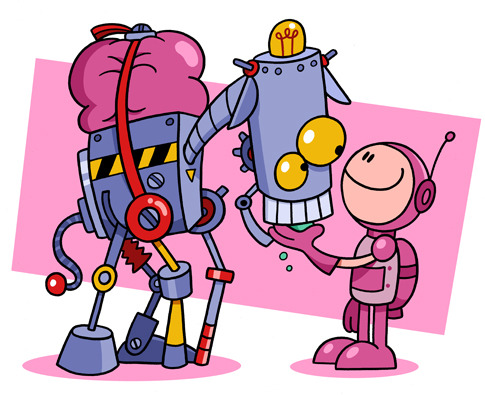
A M.U.L.E. and a Humanoid from M.U.L.E. (Atari and Commodore 64; 1983) developed by Ozark Softscape of Little Rock, Arkansas.
This was a game before my time but I did play it a bit when I was young, at the house of a spoiled friend of mine who owned every system ever, even the ones that predated his birth. I understand M.U.L.E. has since gone on to have a very long life as a cult favourite, and you can even get an official version on iPad now.
12 notes
·
View notes